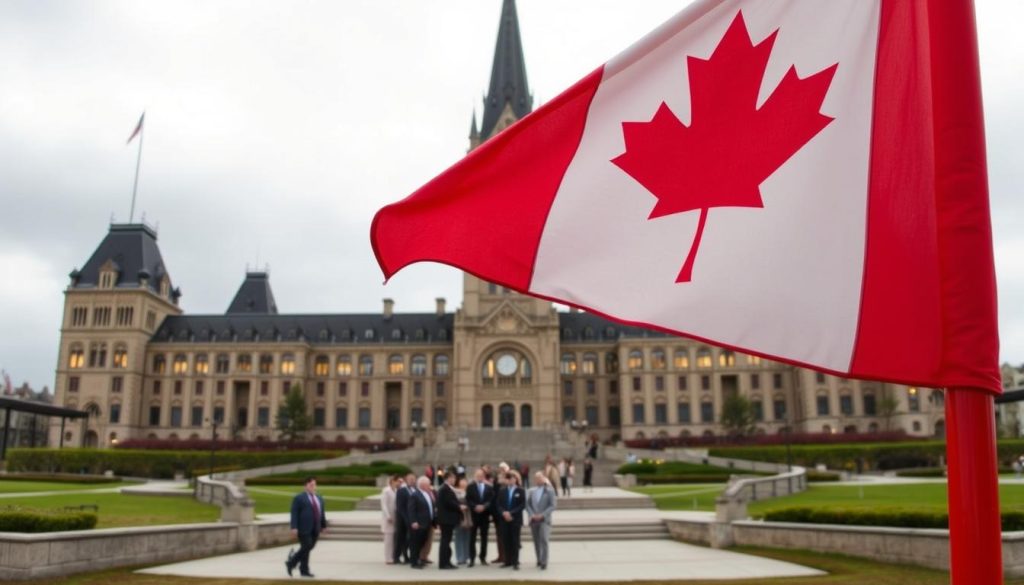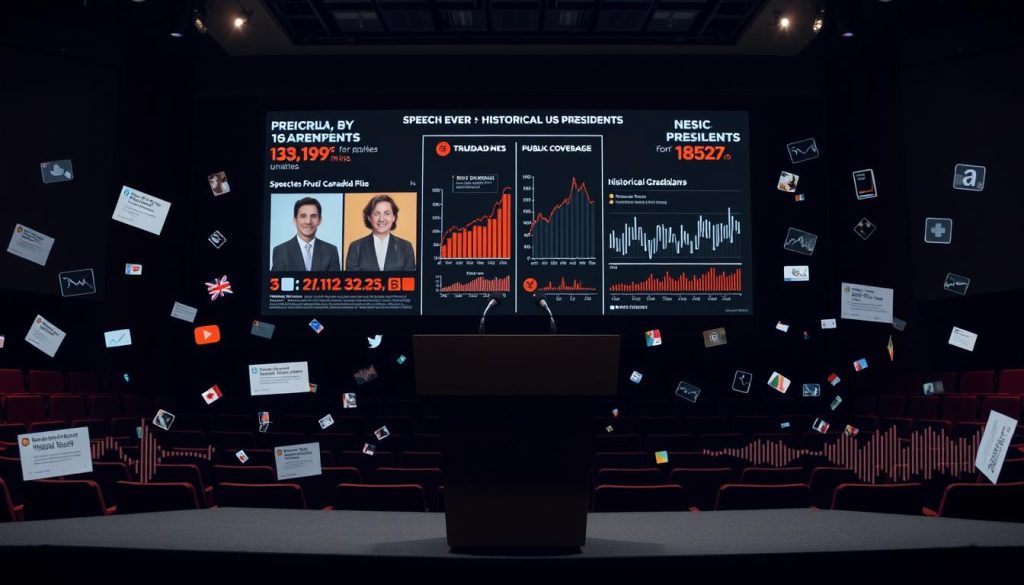In a recent high-profile news conference, the Canadian Prime Minister delivered a strong rebuke of U.S. economic policies. Speaking at the New York Stock Exchange, he criticized the measures imposed by the U.S. administration, describing them as harmful to both nations.
He emphasized that such actions would not go unanswered, signaling potential retaliatory measures. The Prime Minister’s statements came during a critical moment in U.S.-Canada relations, highlighting the growing tension between the two nations.
This confrontation marks a pivotal moment in the ongoing economic discussions. The Prime Minister’s direct language and firm stance reflect the seriousness of the situation. His remarks have sparked widespread attention and debate, setting the stage for further analysis.
Key Takeaways
- The Canadian leader criticized U.S. economic policies during a news conference.
- He warned of potential retaliatory measures in response to these actions.
- The statements were made at the New York Stock Exchange, drawing significant attention.
- This moment highlights growing tensions between the U.S. and Canada.
- The Prime Minister’s remarks set the stage for further economic discussions.
Overview of Trudeau’s Tariff Remarks and Trade War Dynamics
The Canadian leader recently addressed the economic tensions with sharp criticism. His remarks focused on the impact of new policies, which he described as counterproductive. The Prime Minister’s words resonated deeply, drawing attention to the growing friction between the two nations.
During his speech, he labeled the measures as “very dumb” and warned of potential consequences. This strong language underscored the seriousness of the situation. His comments also hinted at possible retaliatory actions, further escalating the tension.
The remarks highlighted the underlying causes of the conflict. By directly addressing the issue, the Prime Minister set the stage for further discussions. His tone reflected a firm stance, signaling that these measures would not go unanswered.
“These actions are not just harmful; they are unnecessary,” he stated, emphasizing the need for cooperation.
This moment marked a pivotal point in the ongoing economic dialogue. The Prime Minister’s approach has sparked widespread debate, with many analyzing the potential outcomes. As the situation unfolds, his remarks will likely shape the future of these discussions.
Context: US-Canada Trade Relations and Recent Tariff History
The history of U.S.-Canada trade relations has seen its share of challenges and disputes. Over the decades, both nations have worked closely to foster economic ties. However, recent measures have tested this longstanding partnership.
Tariffs on Mexican and Canadian imports marked a new chapter in these trade disputes. These actions are part of a larger trend of escalating tensions. The impact on daily trade flows has been significant, affecting the movement of goods between the two nations.
Previous tariff implementations have shaped economic sentiments on both sides. They have influenced how businesses and policymakers approach trade discussions. This context is crucial for understanding the current situation.
As tensions rise, the trade war continues to impact industries and consumers. Each day brings new developments, adding complexity to the economic landscape. This sets the stage for a deeper analysis in the sections ahead.
Analysis of Trudeau’s Critique of US Tariffs
During a pivotal news conference, the Canadian leader delivered a sharp critique of recent economic measures. His remarks were characterized by blunt language, emphasizing the seriousness of the situation. This approach highlighted the growing tension between the two nations and its potential consequences.
Blunt Remarks at the News Conference
The Prime Minister’s tone was direct and unyielding. He described the measures as harmful and unnecessary, warning of their potential to destabilize the Canadian economy. His choice of words underscored the gravity of the situation, leaving little room for misinterpretation.
By addressing the issue head-on, he signaled that these actions would not go unanswered. This firm stance resonated with many, drawing attention to the broader implications of the trade dispute. His remarks also hinted at possible retaliatory measures, further escalating the tension.
Impact on Canadian Economic Sentiment
The critique has had a significant impact on economic sentiment in Canada. Investors and businesses are closely monitoring the situation, wary of potential disruptions. The Prime Minister’s warnings have heightened concerns about the stability of trade relations.
This uncertainty has led to cautious optimism among stakeholders. While some remain hopeful for a resolution, others are preparing for potential challenges. The broader implications of his messaging are still unfolding, shaping the future of economic discussions.
| Aspect | Impact |
|---|---|
| Investor Confidence | Decreased due to uncertainty |
| Business Sentiment | Cautious optimism |
| Trade Relations | Heightened tension |
The Prime Minister’s critique has set the stage for further dialogue. His remarks have sparked widespread debate, with many analyzing the potential outcomes. As the situation evolves, his messaging will likely continue to influence the economic landscape.
Unpacking President Trump’s Tariff Strategy
The U.S. administration’s approach to international trade has sparked significant debate. Central to this strategy is the use of tariffs as a tool to pressure trading partners. By imposing steep tariffs on key products, the goal was to reshape economic dynamics and address perceived imbalances.
This approach was not without consequences. The announcement of these measures led to swift market reactions. Businesses on both sides of the border faced uncertainty, with many adjusting their strategies to mitigate potential disruptions.
One notable example was the introduction of retaliatory tariffs by Canada and Mexico. These measures were a direct response to the trump tariff strategy, highlighting the interconnected nature of global trade. Such actions have further complicated negotiations, with calls for reciprocal measures becoming more frequent.
The broader implications for industries are significant. For instance, the automotive and agricultural sectors have experienced notable shifts. Businesses in these industries are now navigating a more complex landscape, balancing costs and supply chain adjustments.
| Aspect | Impact |
|---|---|
| Market Reactions | Immediate volatility and uncertainty |
| Business Strategies | Increased focus on risk management |
| Trade Negotiations | Heightened calls for reciprocal measures |
| Industry Shifts | Adjustments in supply chains and costs |
As the situation evolves, the long-term effects of this strategy remain uncertain. What is clear, however, is that the use of tariffs has reshaped the economic dialogue between nations. The ongoing discussions will likely continue to influence global trade dynamics for years to come.
Insights from Commerce Secretary Howard Lutnick
Commerce Secretary Howard Lutnick recently shared his perspective on the ongoing trade negotiations, offering a more conciliatory tone compared to other officials. His remarks hinted at a possible compromise, suggesting that both sides might meet in the middle. This approach contrasts sharply with the combative rhetoric seen elsewhere.
Lutnick’s optimism stands out in the current climate of tension. He emphasized the importance of dialogue and mutual understanding, highlighting the potential for a balanced resolution. His comments reflect a pragmatic approach to resolving disputes, focusing on collaboration rather than confrontation.
Contrasting Stances
While some officials have adopted a more aggressive tone, Lutnick’s approach is notably different. He believes that negotiations can lead to positive outcomes if both parties remain open to compromise. This perspective offers a refreshing contrast to the prevailing narrative of conflict.
High-level diplomacy plays a crucial role in managing these discussions. Lutnick’s emphasis on dialogue underscores the importance of maintaining open channels of communication. This approach could pave the way for more productive negotiations in the future.
| Official | Stance |
|---|---|
| Commerce Secretary Howard Lutnick | Optimistic, focused on compromise |
| Other Officials | Combative, emphasizing retaliation |
Lutnick’s insights provide a valuable perspective on the ongoing trade discussions. His focus on collaboration and compromise offers a potential path forward, even in the face of significant challenges. As negotiations continue, his approach may prove instrumental in shaping the outcome.
Reactions from Canadian and International Leaders
Leaders from Canada and other nations have voiced strong opinions on the recent economic measures. Canadian political figures were quick to respond, emphasizing the need for unity and strategic action. International policymakers also weighed in, highlighting the global implications of these developments.
Prominent Canadian leaders described the measures as counterproductive. One official stated, “These actions harm not just one country but the entire global economy.” This sentiment was echoed by policymakers from Mexico, who expressed solidarity with Canada in addressing the challenges.
The responses from these leaders are shaping policy discussions for the remainder of the year. Many are calling for collaborative solutions to mitigate the impact on industries and consumers. This unified stance between Canada and Mexico underscores their commitment to protecting their economies.
Solidarity in the Face of Challenges
Canada and Mexico have shown remarkable solidarity in confronting these measures. Their joint efforts highlight the importance of international cooperation in navigating complex economic landscapes. This partnership is expected to influence future trade negotiations significantly.
As the year progresses, these reactions will likely play a crucial role in shaping policy. Leaders are focused on finding balanced solutions that benefit all parties involved. The ongoing dialogue reflects a shared commitment to fostering stable and productive trade relations.
| Leader | Reaction |
|---|---|
| Canadian Official | Described measures as counterproductive |
| Mexican Policymaker | Expressed solidarity with Canada |
| International Leader | Highlighted global economic implications |
The unified responses from Canada and Mexico demonstrate their resilience in the face of economic challenges. Their actions are setting the stage for meaningful negotiations and potential resolutions in the coming months.
Market Impact: Stock Movement and Business Concerns
The recent tariff announcements have sent shockwaves through the U.S. stock market, sparking concerns among businesses and investors alike. Major indices like the S&P 500 and Dow Jones experienced significant declines, reflecting the uncertainty surrounding these measures. This volatility has raised questions about the stability of the economic landscape.
Effect on US Stock Market Indices
Following the announcements, the S&P 500 dropped by nearly 2%, while the Dow Jones fell by over 300 points. These declines highlight the immediate market reaction to the uncertainty. Investors are closely monitoring the situation, wary of potential long-term effects.
Market sentiment has shifted dramatically, with many anticipating retaliatory measures. This has led to increased volatility, making it challenging for businesses to plan ahead. The economic impact is expected to ripple across various sectors.
Implications for American Retailers and Carmakers
Retail giants like Best Buy and Walmart have expressed concerns over potential price hikes. These businesses rely heavily on imported goods, and the tariffs could significantly increase costs. Automakers are also facing challenges, with supply chain disruptions adding to their woes.
The deal between nations remains uncertain, leaving businesses in a precarious position. As trudeau said, these measures could have far-reaching consequences. The role of secretary howard lutnick in navigating these challenges will be crucial in the coming months.
- Major indices like the S&P 500 and Dow Jones saw sharp declines.
- Retailers and automakers are bracing for potential price hikes and supply chain disruptions.
- Market sentiment has shifted, with increased volatility and uncertainty.
- The economic impact is expected to affect both short-term and long-term business operations.
Retaliatory Measures: Canada’s Response to US Tariffs
Canada has unveiled a strategic plan to counter recent economic measures. The phased approach focuses on minimizing the impact while sending a clear message. This response aims to protect domestic industries and maintain economic stability.

The first phase targets $30 billion worth of American goods. This includes products like steel, aluminum, and agricultural items. By focusing on these sectors, Canada aims to address the immediate economic challenges while preparing for further actions if necessary.
If the situation escalates, additional measures could impact an extra $125 billion in goods. This contingency plan ensures that Canada remains prepared for any developments. The goal is to maintain pressure until the trade dispute is resolved.
These measures may affect consumer prices in both countries. Higher costs for imported goods could lead to increased prices for everyday items. Businesses and consumers alike are closely monitoring the situation to adapt to potential changes.
The strategic plan emphasizes the importance of persistence. Tariffs will remain in place until the underlying issues are addressed. This approach reflects Canada’s commitment to protecting its economic interests.
| Phase | Targeted Goods | Potential Impact |
|---|---|---|
| Phase 1 | $30 billion (steel, aluminum, agriculture) | Immediate economic adjustments |
| Phase 2 | $125 billion (additional sectors) | Long-term economic implications |
Canada’s response highlights the importance of strategic planning in trade disputes. By taking a measured approach, the country aims to balance immediate needs with long-term goals. This strategy ensures that economic stability remains a top priority.
Analysis of Additional Global Tariff Measures
The global economic landscape is witnessing a wave of tariff measures as countries respond to escalating trade tensions. Beyond the U.S.-Canada dynamics, nations like Mexico and China have announced their own financial and trade policies. These actions are reshaping the way international trade operates, with significant implications for industries and workers.
Mexico and China’s Responses
Mexico has introduced targeted tariffs on U.S. goods, focusing on sectors like agriculture and manufacturing. This move aims to protect domestic industries while sending a clear message. Similarly, China has implemented both tariff and non-tariff measures, including restrictions on certain imports and increased scrutiny on foreign investments.
These policies reflect a strategic approach to safeguarding their economies. By taking decisive actions, both countries are demonstrating their commitment to addressing the challenges posed by the current trade environment.
Short-Term and Long-Term Job Impacts
The immediate effects of these measures are already being felt. In the short term, industries reliant on international trade are facing disruptions, leading to potential job losses. For example, manufacturing and agriculture sectors in Mexico are bracing for reduced demand and increased costs.
In the long term, the economic ramifications could be even more profound. As countries adjust their policies, the way businesses operate may change significantly. This could lead to shifts in employment patterns, with some industries shrinking while others expand.
Determining Tariff Responses Over the Coming Months
Countries are carefully evaluating their next steps. Over the next month, policymakers will analyze the impact of their initial measures and adjust their strategies accordingly. This process involves balancing immediate economic needs with long-term goals.
For instance, China is exploring ways to diversify its trade partnerships, reducing reliance on any single market. Mexico, on the other hand, is focusing on strengthening domestic industries to mitigate the effects of external pressures.
Complexities of Multiple Governments Acting Simultaneously
The simultaneous actions of multiple governments add layers of complexity to the global trade landscape. Each country’s policies influence the others, creating a web of interconnected effects. This makes it challenging to predict outcomes and plan for the future.
For example, a tariff imposed by one country may lead to retaliatory measures from another, escalating tensions further. This dynamic underscores the need for coordinated efforts and open dialogue to navigate these challenges effectively.
| Country | Key Measures | Impact |
|---|---|---|
| Mexico | Tariffs on agriculture and manufacturing | Short-term disruptions, long-term industry shifts |
| China | Tariffs and non-tariff restrictions | Reduced trade dependency, increased scrutiny |
As the situation evolves, the global community will continue to monitor these developments. The coming months will be critical in determining the future of international trade and economic stability.
Historical Perspective: Past Trade Wars and Tariff Conflicts
Trade wars and tariff conflicts have shaped economic policies for centuries, offering valuable lessons for today’s leaders. From Woodrow Wilson’s groundbreaking speech to Congress to earlier disputes in U.S. history, these events highlight the complexities of international trade.
One notable example is the Smoot-Hawley Tariff Act of 1930. This legislation raised tariffs on thousands of imported goods, leading to a global trade downturn. The act serves as a cautionary tale, illustrating how aggressive measures can backfire.
Modern trade disputes share similarities with these historical cases. For instance, the current focus on protecting domestic industries echoes the goals of past policies. However, today’s strategies are often more nuanced, reflecting the interconnected nature of the global economy.
“Tariffs are not just economic tools; they are political statements,” said Woodrow Wilson, emphasizing their broader implications.
Over time, tariff strategies have evolved significantly. Early measures were often unilateral, while modern approaches involve multilateral negotiations. This shift reflects a growing recognition of the need for cooperation in addressing trade imbalances.
Comparing Historical and Modern Tariff Strategies
Historical tariff conflicts were typically driven by protectionist goals. Governments aimed to shield domestic industries from foreign competition. In contrast, modern strategies often seek to address broader economic and geopolitical concerns.
For example, the commerce secretary howard has emphasized the importance of balancing economic interests with diplomatic goals. This approach reflects a more holistic view of trade policy, considering both short-term and long-term impacts.
| Era | Primary Goal | Key Strategy |
|---|---|---|
| Early 20th Century | Protectionism | Unilateral tariffs |
| Modern Era | Economic Diplomacy | Multilateral negotiations |
Historical examples also offer insights into potential future policy moves. By studying past successes and failures, policymakers can better navigate the complexities of today’s trade environment. This knowledge is particularly relevant for figures like howard lutnick, who play a key role in shaping economic strategies.
As the global economy continues to evolve, the lessons of history remain invaluable. Understanding past trade wars and tariff conflicts provides a foundation for addressing current challenges and shaping a more stable economic future.
The Role of Pop Culture and Public Sentiment in Trade Wars
Pop culture and public sentiment often mirror the emotional undercurrents of economic conflicts, making trade wars a topic of everyday conversation. From sports events to social media, these disputes influence how people express their national pride and economic concerns.
At NHL and NBA games, for example, the booing of national anthems has become a symbolic protest against trade policies. These reactions highlight the deep emotional impact of economic measures, showing how they resonate beyond policy debates.
Public opinion plays a significant role in shaping policy discussions. When citizens express their dissatisfaction, policymakers often take notice. This feedback loop can influence the implementation of tariffs and other economic measures.
“Trade wars are not just about economics; they are about identity and pride,” said an analyst, emphasizing the cultural dimensions of these conflicts.
The concept of reciprocal tariffs is particularly relevant here. These measures, designed to balance trade relationships, often evoke strong emotional responses. They reflect a nation’s determination to protect its interests while navigating complex economic landscapes.
Consumer behavior is also affected by these sentiments. As public opinion shifts, so do preferences for certain products. For instance, some consumers may choose locally made goods over imported ones, reflecting their support for domestic industries.
Cultural Impacts of Trade Wars
Trade wars influence more than just economic policies; they shape cultural narratives. From art to entertainment, these conflicts become part of the national conversation, reflecting broader societal concerns.
For example, films and television shows often incorporate themes of economic struggle, resonating with audiences who feel the impact of these disputes. This cultural representation underscores the interconnectedness of economics and everyday life.
| Aspect | Impact |
|---|---|
| Sports Events | Symbolic protests like anthem booing |
| Consumer Choices | Preference for local products |
| Media Representation | Themes of economic struggle in films and TV |
As secretary howard noted, understanding these cultural dynamics is crucial for effective policymaking. By recognizing the emotional and cultural dimensions of trade wars, leaders can craft strategies that address both economic and societal needs.
Ultimately, the interplay between pop culture, public sentiment, and economic policy highlights the complexity of trade wars. These conflicts are not just about numbers; they are about people, their identities, and their daily lives.
Coverage Comparison: Trudeau vs. Historical Presidential Speeches
Political speeches have always been a powerful tool for shaping public opinion and economic policies. The way leaders deliver their messages often reflects the challenges and priorities of their time. Comparing modern addresses, like Trudeau’s recent remarks, with historical speeches reveals fascinating insights into the evolution of political communication.

Media Coverage Then and Now
Media coverage of political speeches has changed dramatically over the decades. In the past, addresses like Woodrow Wilson’s in-person message to Congress were groundbreaking. Today, Trudeau’s speeches are instantly broadcast globally, reaching millions in real-time. This shift has amplified the impact of modern leaders’ words.
Historical speeches often focused on unifying the nation during crises. Modern addresses, however, tend to address complex global issues. This difference in focus is reflected in the tone and delivery of these messages.
Tone, Delivery, and Public Reaction
Trudeau’s direct style contrasts sharply with the more formal tone of historical speeches. For example, Wilson’s address emphasized unity and cooperation, while Trudeau’s remarks often highlight immediate economic concerns. This shift in tone mirrors the changing priorities of leaders and their audiences.
Public reactions have also evolved. In the past, speeches were met with widespread optimism. Today, reactions are more polarized, reflecting the diverse perspectives of modern societies.
Trump’s Comments and Historical Context
Trump’s remarks on trade and economic policies often draw comparisons to historical moments. For instance, his focus on protecting domestic industries echoes the goals of past leaders. However, his approach is more confrontational, reflecting the complexities of today’s global economy.
As trump said, “We must prioritize our industries to remain competitive.” This statement highlights the ongoing debate over trade policies and their impact on national economies.
Market Reactions: Then vs. Now
Market reactions to political speeches have also changed. In the past, addresses like Wilson’s often boosted investor confidence. Today, speeches like Trudeau’s can lead to immediate volatility in the market. This shift reflects the interconnected nature of modern economies.
For example, recent tariff announcements caused significant fluctuations in stock indices. This immediate response underscores the heightened sensitivity of today’s market to political developments.
| Aspect | Historical Speeches | Modern Speeches |
|---|---|---|
| Tone | Formal, unifying | Direct, issue-focused |
| Media Coverage | Limited, delayed | Instant, global |
| Public Reaction | Optimistic | Polarized |
| Market Impact | Boosted confidence | Immediate volatility |
The evolution of political communication styles reflects broader societal changes. From Woodrow Wilson to Trudeau, each leader’s approach offers unique insights into the challenges of their time. As the thing continues to evolve, understanding these shifts is crucial for navigating the complexities of modern politics and economics.
Importance of the Trade War in the US-Canada Economic Landscape
The ongoing trade dispute between the United States and Canada has become a defining factor in their economic relationship. This conflict is reshaping policies and influencing markets on both sides of the border. The immediate effects of these measures are already being felt across key industries.
Tariffs imposed by the trump administration have created significant challenges for businesses. These actions aim to protect domestic industries but have also led to disruptions in supply chains. The concept of tariff immediately highlights the urgency of these economic responses.
Industries like automotive and agriculture are particularly affected. For example, Canadian farmers face reduced access to U.S. markets, while American manufacturers deal with higher costs for raw materials. These shifts underscore the interconnected nature of the two economies.
Strategic responses from both nations are crucial. Canada has introduced retaliatory measures to protect its interests, while the United States continues to refine its approach. This back-and-forth reflects the complexity of modern trade negotiations.
“Trade disputes are not just about economics; they are about national priorities and global influence,” said an economic analyst.
The long-term implications of this trade war are still unfolding. Policymakers must balance immediate economic needs with future stability. As the situation evolves, the relationship between the United States and Canada will continue to shape the global economic landscape.
Coverage Comparison: Trudeau vs. Historical Presidential Speeches
Leadership in times of economic tension often reflects the broader strategies of an administration. By comparing modern responses to historical ones, we gain insights into how governments navigate complex challenges. This analysis highlights the interplay between past and present approaches to trade disputes.
Press Coverage: Then and Now
Media coverage of political speeches has evolved significantly. In the past, addresses like Woodrow Wilson’s were groundbreaking but limited in reach. Today, leaders’ remarks are instantly broadcast globally, amplifying their impact. This shift reflects the changing dynamics of political communication.
Leadership Actions: Historical vs. Modern
Historical leaders often focused on unifying the nation during crises. Modern leaders, however, address complex global issues with a more direct tone. This difference in approach highlights the evolving priorities of governments and their audiences.
“Leadership is about adapting to the challenges of the time,” said a political analyst, emphasizing the importance of context.
Public Perception and Government Policies
The way a person perceives their government is shaped by its actions. Historical speeches often inspired optimism, while modern remarks can polarize public opinion. This shift underscores the emotional and cultural dimensions of political leadership.
Understanding these dynamics is crucial for effective policymaking. By recognizing the human aspect of governmental decisions, leaders can craft strategies that resonate with their citizens.
| Aspect | Historical Speeches | Modern Speeches |
|---|---|---|
| Tone | Formal, unifying | Direct, issue-focused |
| Media Coverage | Limited, delayed | Instant, global |
| Public Reaction | Optimistic | Polarized |
By examining these differences, we gain a deeper understanding of how leadership styles shape public perception and policy outcomes. This analysis provides valuable insights for navigating the complexities of modern governance.
Future Implications for Trade and International Relations
As global trade tensions persist, leaders like President Claudia Sheinbaum are signaling a shift toward non-tariff measures to reshape international relations. These strategic moves could redefine how nations interact economically and politically in the post-tariff era.
Experts suggest that the current trade disputes may lead to innovative approaches to economic policy. Non-tariff measures, such as regulatory changes and investment restrictions, are gaining traction as alternatives to traditional tariffs. These methods aim to address trade imbalances without escalating conflicts.
Potential Outcomes and Strategic Decisions
One possible outcome is the increased use of bilateral agreements to bypass multilateral trade frameworks. This approach allows nations to tailor agreements to their specific needs, fostering stronger partnerships. However, it also risks fragmenting the global trade system.
Another key factor is the role of timely decisions in mitigating risks. Leaders must balance immediate economic needs with long-term stability. Delayed actions could exacerbate tensions, while proactive measures may pave the way for smoother negotiations.
Expert Opinions on Future Policies
Analysts predict that future policies will focus on sustainability and resilience. For instance, countries may prioritize domestic production to reduce reliance on imports. This shift could lead to significant changes in supply chains and consumer behavior.
Collaboration will remain crucial in navigating these challenges. As President Claudia Sheinbaum noted, “Cohesive diplomacy is essential to addressing the complexities of modern trade.” Her emphasis on unity highlights the importance of collective action in shaping the future of international relations.
| Key Aspect | Implications |
|---|---|
| Non-Tariff Measures | Regulatory changes, investment restrictions |
| Bilateral Agreements | Tailored partnerships, potential fragmentation |
| Timely Decisions | Mitigating risks, fostering stability |
| Sustainability Focus | Domestic production, supply chain shifts |
The evolving trade landscape underscores the need for adaptability and foresight. As nations navigate these changes, the post-tariff era will likely bring both challenges and opportunities. Leaders must remain vigilant and collaborative to ensure a balanced and prosperous future.
Conclusion
The ongoing economic tensions highlight the critical role of decisive action in shaping international relations. Leaders from both nations have taken steps that underscore the importance of balancing domestic priorities with global cooperation. These measures have had a profound impact on the economy, influencing industries and consumers alike.
As the situation evolves, the focus shifts to the future of trade policies. The lessons learned from this period will likely guide future decisions, ensuring a more resilient and collaborative approach. The broader implications of these actions extend beyond immediate economic concerns, shaping the way nations interact on the global stage.
In the end, the ability to adapt and respond effectively will determine the success of these efforts. By prioritizing dialogue and mutual understanding, leaders can pave the way for a more stable and prosperous future.
FAQ
What did the Canadian leader say about the recent tariffs?
The Canadian leader expressed strong disapproval of the new tariffs, calling them harmful to both economies. He emphasized the need for fair and balanced trade policies.
How has the trade conflict affected US-Canada relations?
The trade conflict has strained relations, leading to increased tensions and retaliatory measures. Both countries are working to find a resolution that benefits all parties involved.
What was the focus of the Commerce Secretary’s remarks?
The Commerce Secretary highlighted the importance of protecting domestic industries while fostering international cooperation. He also discussed strategies to mitigate the impact of tariffs on businesses.
How have global markets reacted to the trade war?
Global markets have experienced volatility, with stock indices fluctuating in response to trade developments. Businesses, especially in retail and automotive sectors, are closely monitoring the situation.
What steps has Canada taken in response to the tariffs?
Canada has implemented retaliatory tariffs on certain US goods. These measures aim to protect Canadian industries and encourage a return to negotiations.
What historical context is relevant to this trade conflict?
Past trade wars, such as those in the 20th century, provide insights into the potential long-term effects of tariffs. Historical examples highlight the importance of diplomacy in resolving disputes.
How has public sentiment influenced the trade war?
Public opinion has played a significant role, with many citizens expressing concern over rising prices and job losses. Pop culture and media coverage have also shaped perceptions of the conflict.
What are the future implications of this trade war?
The trade war could reshape international trade policies and alliances. Experts predict ongoing negotiations and potential shifts in global economic dynamics.


